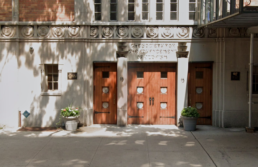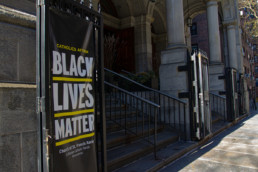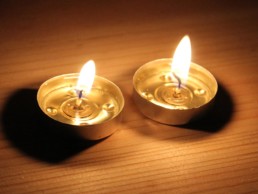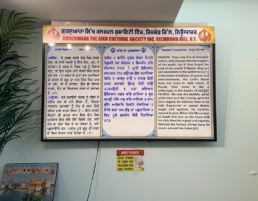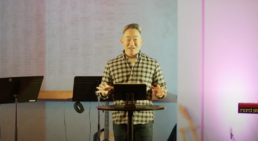A Renewed Connection on the Upper West Side
Every Sunday since the pandemic began Hope West Side hosts two services. The evangelical Christian congregation rents the sanctuary of the Society for the Advancement of Judaism on West 86th Street and Central Park West. Inside you won’t see a cross, but you will see Jewish symbols in the colorful stained-glass windows. Under every seat are Shabbat prayer books instead of Christian Bibles. Hope West Side is a newer congregation, only founded in 2018. Because the Society for the Advancement of Judaism holds its services on Saturdays, it allows Hope West Side to have the space on Sundays. When the pandemic hit, though, the building went dark and both the Jewish and the Christian congregations were homeless.
The services went online, starting out with pre-recorded live streams and moving on to Zoom meetings, but some of those involved with the church felt this deprived them of a sense of community within the church. Christina Jackson serves as the communications director and tries to engage members during the year of virtual worship.
“I think it’s hard because part of the reason why I come to church at least is for the community,” Jackson said. “We tried our best to have the chat box going on the YouTube Live Stream and reach out to people we were already connected with, but for new people, it was really hard.”
Finally, last June, after 14 months, the church was able to hold services in person, while also streaming to the web, but not without challenges. The church had to purchase and set up cameras, WIFI and projectors. In the back of the worship space a large camera manned by volunteers captures the worship music, the sermon and then the worship music again, but of course it misses the connection between worshipers before and after the services. Those who did attend in person, didn’t fully get that connection either.
The Society for the Advancement of Judaism lowered the number of people permitted in the building at any given time, to ensure proper social distancing requirements were met. Hope West Side switched from holding one service, as they did before the pandemic, to two services. This way, half of the churchgoers would attend each one, with around 30 at each. This worked for a while, but once the Society for the Advancement of Judaism lifted that restriction, Pastor Mike Park enthusiastically announced that the congregation would return to one service. This announcement was met with cheers from the churchgoers.
“I realize there’s a couple things that we’ve lost in having two services,” Park said. “We are never in the same room together.”
On February 27th, Hope West Side held their first in-person singular service since the beginning of March 2020. Nearly every seat was filled, with around 70 people in attendance, all wearing the name tags given to them at the door when they completed their Covid-19 screenings. Before and after the service people laughed and talked. They poured and sipped on coffee provided in the lobby. This 11 AM service represented a return to normalcy after nearly two years navigating Covid-safe services.
Along with this return, came the announcement of the first church retreat in two years. Taylor Fagins is the community life coordinator at the church and was excited to inform everyone of the trip upstate.
“It’s gonna be amazing, and I say that because I planned it,” he said to the congregation with an enthusiastic smile. This was met with laughter. “There’s gonna be hiking, board games, there might be some karaoke.”
Still, the church does take precautions to keep everyone safe, such as required masking and then health screenings at the door. They look forward to a time when they won’t have to do these things anymore.
“Maybe somewhere down the line we can unmask,” said Christina Jackson. “I think we are just playing it by ear and just doing what the whole city is doing: trying to keep everyone safe.”
Social Justice Meets the Mass
Counting hymnal mentions, the word ‘mercy’ was intoned 37 times during the 9 a.m. service on a recent Sunday at St. Francis Xavier, a Roman Catholic church in the Jesuit tradition, snugly situated in the Flatiron District neighborhood of Manhattan.
The Rev. Kenneth Boller made the concept of mercy progressively applicable throughout the service. After an hour of traditional Catholic liturgy, he led the congregation in a more contemporary affirmation.
“Do you affirm that white privilege is unfair and harmful to those who have it and to those who do not? Do you affirm that white privilege and the culture of white supremacy must be dismantled where it is present? Do you support racial equity justice and liberation for every person? Do you affirm the inherent worth and dignity of every person?"
The congregation of 100 people answered “yes” to each of these questions with enthusiasm. In so doing, the members of St. Francis Xavier have been committing themselves to these social justice principles every week since the affirmation was first introduced on Aug. 30, 2020.
Since then, some conservative commentators have attacked gone on the attack. A few agitated Twitter users have accused Boller of turning his service into “a left-wing political rally.” Videos of the service have gone viral. The conservative entertainment company Blaze Media, which reaches 165 million people every month, published an article calling the statements “revolting.” Trudging past online criticism, Boller’s affirmations prevailed.
Doing no harm is a form of activism, Boller said. Led by the Holy Spirit, Catholics ought to be able to avoid harming all people via radical mercy.
The Church of St. Francis Xavier is unafraid to live in the tension between tradition and progress. Comfortable with anachronism, this house of worship is a place where Boller, the church’s pastor standing at a pulpit built in 1850, will readily grapple with issues like cyberbullying and misinformation on social media. This conflict echoes the tensions within American Catholicism today. The religious are taking sides between loyalty to a centuries-old establishment and dissent. But this Jesuit congregation rejects the binary altogether - in the name of mercy.
In his Sunday sermon, Boller took on everyone from the Biblical David to the contemporary leaders of the Roman Catholic Church.
The scriptural reference in the homily, or the commentary lesson that follows worship, was 1 Samuel 26. In this part of the Bible, David spared his sleeping enemy, Saul, who was the first king of Israel with a militaristic streak. David, who will (spoiler alert) eventually replace Saul as Israel’s leader, justified his merciful choice to not stab his adversary when he said, “Do not destroy Saul, for who can put out his hand against the Lord's anointed people and be guiltless.” David believed God valued some lives more than others; God prioritized the blessed nation of Israel above those of any other descent or station Boller explained.
Boller went on to commend David’s choice to do no harm but criticized David’s reasoning for doing so. Peaceful action without equitable intention is not good enough, the Queens-native pastor argued. The key to not harming others is knowing God loves all people equally, he added, this democratization of access to salvation hinges on living out the Gospel. Do not be like David, Boller said to his audience.
Deliberately not causing harm is a high Catholic standard that extends politically, interpersonally, virtually, physically, racially, emotionally and sexually. At that last point, Boller waved his hands around to referentially gesture the credible claims of abuse plaguing Catholic leadership. Thereafter, Boller brought up the famous creed of bioethics and a variation of the Hippocratic Oath, “First, do no harm,” which Boller said should be applied by the scientific and religious alike. Catholics are not appointed to punish the people who wrong them. Quite the opposite is true, Boller concluded. Much like the medical field, Boller said, the Catholic tradition possesses a life-giving tool of mercy, which should lead worshippers to accomplish good in the world. The Catholic ideals entail turning the other cheek, (Matthew 5:39).
“Differences of power and resources just give some people more responsibility of helping the common good,” Boller said.
Meeting the Shabbat Bride
As the sun set on Friday evening, the congregation at Stephen Wise Free Synagogue sat at least six feet apart from each other, indicating a sign of the pandemic that’s engulfed the world for the past two years. The service began with six songs led by Cantor Daniel Singer, from the Kabbalat Shabbat, one to symbolize each day of the preceding week leading up to this service.
As the songs continued, everyone in attendance remained standing, facing the front of the Synagogue, where the Torah rests and the Cantor stands. Some participants clap to the beat of the song. Others gently rock back and forth. Some do a combination of both. Each song flows from one into another, with no break. The melodies merge from one to the next, with Cantor Singer saying which page to turn to in between the first verse of the songs.
On the seventh song, the service changes unexpectedly and without warning.
With no prompting from the cantor, everyone silently turns towards the back of the synagogue before they start singing, with no prompting from the Cantor. They all know what to do. Next steps and movements are all ingrained, as they slowly turn around while singing. The flow of the service up until this point could be analogized with the beginning of a traditional Western wedding. There is a prelude of songs, where everyone faces the front, and then when it is time for the bride to make her grand entrance, the crowd faces her. Each person smiles as they sing the seventh song, welcoming the long-awaited day of rest as if it were a young woman walking down the aisle.
Instead of focusing on the memorial plaques on the rear wall, all eyes are on the main door of the synagogue. For the remainder of the song, the door is the main focus. The clapping and rhythmic movement ceases, as they usher in the true beginning of Shabbat.
A small red light turns on next to some names on the memorial back wall. The lights symbolize an anniversary of death. But, death is not the focus in this ritual. Instead, the focus is the ultimate symbol of love and life, marriage.
In this case, the bride is the Shabbos everyone is welcoming. The lyrics of the song translate in English to, “Beloved, come to meet the bride; beloved come to great Shabbat.”
Singer explained that this tradition comes from the Jewish Mystical tradition, the Kabbalah. Welcoming Shabbat as a bride, he said, “is a metaphor for the time of redemption.” The Hebrew, “Boi Kallah,” means “come my beloved.” One day, the goal is to reach a day when the Messiah will come, and everyone will be peace.
“We pray for a day when we’ll be able to have Shabbat rest all the time,” Singer said.
Sikhs in Queens Pay Tribute to Prominent Figures Old and New
On Sunday at The Sikh Cultural Society gurdwara at 118th Street in South Richmond Hill, Queens, a crowd of Sikh worshippers slip off their shoes and make their way to the Darbar Sahib for the day’s service. The women, many displaying their gold-adorned kurti tops, sit to the left of the hall. Men sit scattered on the burgundy carpet to the right of the room in rows. Their vibrant turbans in orange, turquoise, yellow and white dot half of the massive hall.
Though each worshiper performs daily readings on their own, they gather en masse at the gurdwara to learn from the Granthi’s interpretation of the Guru Granth Sahib. Granthis serve as guardians over the Sikh holy book, Guru Granth Sahib. Before the devoted hear the scripture, they see it. The seafoam green walls in the main hall display the day’s scripture in the Punjabi Gurmukhi script. Beside it is the English translation. This hukam, as it is called, is chosen at random and serves as the day’s guiding principle. Later on in the service, the gurus will recite and decipher the meaning.
There is a celebration of both life and death occurring on this Sunday. The usual crowd looms larger than previous ones. The seventh guru, Har Rai Sahib Ji, has a birthday. For Sikhs, this guru who died in the 17th century is revered for his military leadership. Across the hall from the hukam are images plastered in remembrance of Deep Sidhu, a famous Indian actor, lawyer and activist, who died the same week. Sidhu had been vocal in the recent Indian farmers’ protest about his support for the working class farmers against the Indian government. He is also a hero to those of Sikh faith.
The afternoon prayers begin with a memorial service to the late actor and activist. A man behind a podium makes a booming speech in Punjabi into a microphone. As he stands behind the podium addressing the room, he is being live-streamed online. He informs the youth in the room about Sidhu’s efforts, encouraging them to advocate for their beliefs like Sidhu. This message fell in line with a Sikh core tenet and practice, which is service to humanity and political activism.
The service transitions to singing from the youth. Six girls and two boys sing kirtan, songs of praise to God. Two girls in front played the harmoniums while off to the corner, one boy knocked the tabla drums to a beat. The song is chosen at random days before but prepared and sung according to the mood. Before harmoniums were introduced by the British to India, string instruments were played by the Sikh women for this practice. The harmoniums are easier to play but the string instruments require a skilled craft to turn out musical notes.
The worshipers sing along to the hymns but most make the descent to the basement’s kitchen for langar. When they return, the reading from Guru Granth Sahib is underway. In the prayer room, the elephantine book sits higher than everyone else. As a holy text, it must always be elevated. The Granthi sits behind it; his black turban peeping from the backdrop of a gold khanda, the Sikh symbol of swords. People stand with their hands clasped listening to the Granthi recite from the holy book in Punjabi. Once allowed to sit, they retreat to the carpet—legs crossed, listening intently.
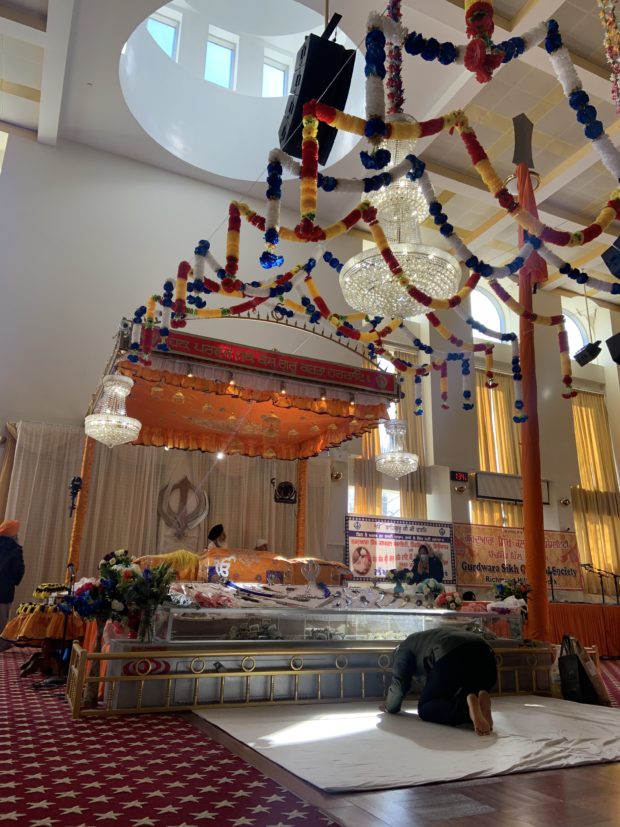 The Granthi is joined by a second Granthi who serves as the translator of the sacred text. In Punjabi, he explains what was just read from the scripture. All the while, the guardian of the holy text steadily waves a large canary yellow scepter, known as a chaur sahib, around the book. The chaur sahib is a ceremonial ornament that on one end is bejeweled and on the other, extended with animal hair that bears a strong resemblance to a horse’s tail.
The Granthi is joined by a second Granthi who serves as the translator of the sacred text. In Punjabi, he explains what was just read from the scripture. All the while, the guardian of the holy text steadily waves a large canary yellow scepter, known as a chaur sahib, around the book. The chaur sahib is a ceremonial ornament that on one end is bejeweled and on the other, extended with animal hair that bears a strong resemblance to a horse’s tail.
Faint whispers can be heard throughout the hall as people recite the scripture to themselves. Some younger Sikhs follow the words on apps on their phone. Then they all join in song. Some vocals pitch higher in the crowd and they sing out loud alone, as the music moves them.
Afterwards, people line up on the long wood panel corridor and prepare to bow and make optional donations in front of the shrine where the Granthi sat protecting the holy book. Once the initial bowing is over, some travel around the holy shrine area where they make additional bows and prayers around the square. A final prayer is said, internally or through a pale voice, at a pole dressed with the bright orange nishan sahib flag, where hands make a delicate touch before parting from the area.
When the service is over, the Guru Granth Sahib is draped with a vivid orange cloth beaded in Indian designs, known as the rumala, awaiting its removal to the upper floor of the gurdwara, where it will stay enclosed in a locked room until morning comes again.
A Prayer By Our Father, For His People
A man with a handheld microphone stands at the front of the room. Behind him, the wall is cast with lilac lights. He’s Taylor Figgins, the community life coordinator at Hope West Side, a church located on 86th Street and Central Park West.
“Let’s stand and pray the Lord's Prayer together,” he says in a soft voice.
The room of about 25 people shifts and every single person stands to recite the prayer. The creaking of chairs and brushing of coats and bags echo in the room as they do this. Some lift their bibles or their notebooks from their laps with them. Once standing they turn and lean down to place the books on the seats behind them. They bow their heads and close their eyes. Many clasp their hands together, while others open their arms out in front of themselves to “open themselves up to Jesus.” There are two screens at the front of the congregation, one on each side of the room. The words to The Lord’s Prayer appear on each one. The crowd recites it quietly in unison, some from memory and some reading off the screens.
Hope West Side is a progressive Evangelical Church established in 2018. The churchgoers recite the Lord’s Prayer at the same moment at every service: right before the sermon.
“We pray the Lord’s Prayer as a way to connect our Hope West Side church community to the generations of believers who have prayed this prayer since the beginning of the early church,” said Park.
“Our Father in heaven,
hallowed be your name,
your kingdom come,
your will be done,
on earth as it is in heaven.
Give us today our daily bread.
And forgive us our debts,
as we also have forgiven our debtors.
And lead us not into temptation,
but deliver us from the evil one.”
“For Yours is the kingdom and the power and the glory forever. Amen.”
Figgins says each phrase gently, taking time to pause in between each one. As they recite the prayer, one word is louder than all the rest. Everyone says Amen with certainty. This closes out the prayer and they all sit down to listen to the pastor’s prepared sermon.
This prayer is from the New Testament in Matthew 6:9-13. In this passage, Jesus explains to the disciples how they should pray, and recites this prayer as an example. The last line comes from newer versions of the bible and church tradition, whereas the rest is from the ancient text.
“It gives us a template for how Jesus wants us to pray,” says Pastor Mike Park, who sits in the front row. He says the prayer with his head bowed. “We could also say it’s the prayer that is formulated by God for us, while most of our prayers are formulated by us for God.”
He views this prayer as a point of connection between all Christian denominations.
“It’s also one of the oldest recorded Christian prayers and is common to the different streams of Christian faith: Protestant, Orthodox, Catholic,” Park says. “So it’s one of the prayers that we can usually pray together regardless of church background or tradition.”
For some believers, the prayer serves as a point of connection between themselves and God, one that they feel can and should be made often.
“There are many seasons where I will pray the Lord’s Prayer slowly several times a day, pausing at each line to think through the truth of that part of the prayer,” says Park.

